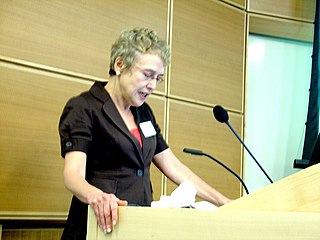Related Research Articles

A subculture is a group of people within a cultural society that differentiates itself from the conservative and standard values to which it belongs, often maintaining some of its founding principles. Subcultures develop their own norms and values regarding cultural, political, and sexual matters. Subcultures are part of society while keeping their specific characteristics intact. Examples of subcultures include BDSM, hippies, hipsters, goths, steampunks, bikers, punks, roadmen, gopniks, hip-hoppers, metalheads, otakus, furries and cosplayers. The concept of subcultures was developed in sociology and cultural studies. Subcultures differ from countercultures.
New musicology is a wide body of musicology since the 1980s with a focus upon the cultural study, aesthetics, criticism, and hermeneutics of music. It began in part a reaction against the traditional positivist musicology of the early 20th century and postwar era. Many of the procedures of new musicology are considered standard, although the name more often refers to the historical turn rather than to any single set of ideas or principles. Indeed, although it was notably influenced by feminism, gender studies, queer theory, postcolonial studies, and critical theory, new musicology has primarily been characterized by a wide-ranging eclecticism.
Cultural history combines the approaches of anthropology and history to examine popular cultural traditions and cultural interpretations of historical experience. It examines the records and narrative descriptions of past matter, encompassing the continuum of events about a culture.

Communication studies or communication science is an academic discipline that deals with processes of human communication and behavior, patterns of communication in interpersonal relationships, social interactions and communication in different cultures. Communication is commonly defined as giving, receiving or exchanging ideas, information, signals or messages through appropriate media, enabling individuals or groups to persuade, to seek information, to give information or to express emotions effectively. Communication studies is a social science that uses various methods of empirical investigation and critical analysis to develop a body of knowledge that encompasses a range of topics, from face-to-face conversation at a level of individual agency and interaction to social and cultural communication systems at a macro level.

It is generally recognized that the first radio transmission was made from a temporary station set up by Guglielmo Marconi in 1895 on the Isle of Wight. This followed on from pioneering work in the field by a number of people including Alessandro Volta, André-Marie Ampère, Georg Ohm and James Clerk Maxwell.
In a society, high culture is the subculture that encompasses the cultural objects of aesthetic value, which a society collectively esteem as being exemplary works of art, and the intellectual works of literature and music, history and philosophy, which a society consider representative of their culture.
Radio broadcasting has been used in the United States since the early 1920s to distribute news and entertainment to a national audience. In 1923, 1 percent of U.S. households owned at least one radio receiver, while a majority did by 1931 and 75 percent did by 1937. It was the first electronic "mass medium" technology, and its introduction, along with the subsequent development of sound films, ended the print monopoly of mass media. During the Golden Age of Radio it had a major cultural and financial impact on the country. However, the rise of television broadcasting in the 1950s relegated radio to a secondary status, as much of its programming and audience shifted to the new "sight joined with sound" service.

Emmis Communications is an American media conglomerate based in Indianapolis, Indiana. Emmis, based on the Hebrew word for Truth (Emet) was founded by Jeff Smulyan in 1980. Emmis has owned many radio stations, including KPWR and WQHT, which have notoriety for their Hip Hop Rhythmic format as well as WFAN, which was the world's first 24-hour sports talk radio station. In addition to radio, Emmis has invested in TV, publishing, and mobile operations around the United States.
Christopher H. Sterling is an American media historian. Sterling is professor of media and public affairs at The George Washington University where he has taught since 1982. Author of numerous books on electronic media and telecommunications plus a host of research and bibliographic articles, his primary research interests center upon the history and policy development of electronic media and telecommunications. He regularly teaches courses in media law and federal regulation and society. He was an acting chair in the early 1990s and served as associate dean for graduate studies in arts and sciences from 1994 to 2001.
Public humanities is the work of engaging diverse publics in reflecting on heritage, traditions, and history, and the relevance of the humanities to the current conditions of civic and cultural life. Public humanities is often practiced within federal, state, nonprofit and community-based cultural organizations that engage people in conversations, facilitate and present lectures, exhibitions, performances and other programs for the general public on topics such as history, philosophy, popular culture and the arts. Public Humanities also exists within universities, as a collaborative enterprise between communities and faculty, staff, and students.
Mediatization is a process whereby the mass media influence other sectors of society, including politics, business, culture, entertainment, sport, religion, or education. Mediatization is often understood as a process of change or a trend, similar to globalization and modernization, where the mass media are integrated to an increasing degree into other sectors of the society. Political actors, opinion makers, business organizations, civil society organizations, and others have to adapt their way of communication to a form that suits the needs and preferences of the mass media – the so-called media logic. Any person or organization who want to spread their messages to a larger audience have to adapt their messages and communication style to make it attractive for the mass media.
Jeffrey Howard Smulyan is the founder and chief executive officer of Emmis Communications.
International communication is the communication practice that occurs across international borders. The need for international communication was due to the increasing effects and influences of globalization. As a field of study, international communication is a branch of communication studies, concerned with the scope of "government-to-government", "business-to-business", and "people-to-people" interactions at a global level. Currently, international communication is being taught at colleges worldwide. Due to the increasingly globalized market, employees who possess the ability to effectively communicate across cultures are in high demand. International communication "encompasses political, economic, social, cultural and military concerns".
In cultural studies, media culture refers to the current Western capitalist society that emerged and developed from the 20th century, under the influence of mass media. The term alludes to the overall impact and intellectual guidance exerted by the media, not only on public opinion but also on tastes and values.
Robert George Lee is an associate professor of American Studies at Brown University. He has authored key texts in Asian American Studies and, nominated by his current and former students and his colleagues, was awarded the Association for Asian American Studies' Lifetime Achievement Award in 2020.
The Chinese Historical Society of New England (CHSNE) is a historical society located in Boston, Massachusetts that was founded in 1992. It was founded with the directive to document Chinese American immigration in the New England region.
Censorship in the Czech Republic had been highly active until 17 November 1989 and the fall of Communism in the former Czechoslovakia. Czech Republic was ranked as the 13th most free country in the World Press Freedom Index in 2014.
Susan Laura Mizruchi is professor of English literature and the William Arrowsmith Professor in the Humanities at Boston University. Her research interests include nineteenth- and twentieth-century American literature, religion and culture, literary and social theory, literary history, history of the social sciences, and American and Global Film and TV. Since 2016, she has served as the director of the Boston University Center for the Humanities.

Carolyn Marvin is a professor and author that specializes in communication, culture and media, political communication, and technology and society. Marvin is currently the Frances Yates Emeritus Professor of Communication at the University of Pennsylvania's Annenberg School for Communication. Marvin is the author of two major publications, When Old Technologies Were New and Blood Sacrifice and the Nation: Totem Rituals and the American Flag.

Richard Davis is a professor and author. He is a professor emeritus at Brigham Young University. He is the author of several books and articles in American politics, including Web of Politics, Electing Justice, Supreme Democracy, and Campaigning Online.
References
- ↑ "Smulyan, Susan". vivo.brown.edu. Retrieved 2020-08-01.
- 1 2 "Susan Smulyan - Routledge & CRC Press Author Profile". www.routledge.com. Retrieved 2020-08-01.
- ↑ "Smulyan, Susan". vivo.brown.edu. Brown University. Retrieved 31 December 2017.
- ↑ "SUSAN SMULYAN" (PDF). Retrieved 31 December 2017.
- ↑ "Smulyan, Susan". vivo.brown.edu. Brown University. Retrieved 31 December 2017.
- ↑ Benjamin, Louise (1 July 1994). "Susan Smulyan, Selling Radio: The Commercialization of American Broadcasting, 1920-1934. Washington: Smithsonian Institution Press, 1994". American Journalism. 11 (3): 293–294. doi:10.1080/08821127.1994.10731655. ISSN 0882-1127.
- ↑ B., Kielbowicz, Richard (1 October 1995). "Susan Smulyan. Selling Radio: The Commercialization of American Broadcasting, 1920–1934. Washington, D.C.: Smithsonian Institution. 1994. Pp. viii, 223. $24.95". The American Historical Review. 100 (4). doi:10.1086/ahr/100.4.1318-a. ISSN 0002-8762 . Retrieved 31 December 2017.
- ↑ Ryan, William James (1 October 2000). "Selling Radio: The Commercialization of American Broadcasting 1920 - 1934". American Journalism. 17 (4): 145–147. doi:10.1080/08821127.2000.10739285. ISSN 0882-1127. S2CID 220315243.
- ↑ Blaszczyk, Regina Lee (1996). "Review of Selling Radio: The Commercialization of American Broadcasting, 1920-1934". The Business History Review. 70 (4): 602–604. doi:10.2307/3117322. JSTOR 3117322. S2CID 154969912.
- ↑ "Prior Board Members - New Urban Arts". newurbanarts.org. Retrieved 2018-03-30.
- 1 2 "Doing Public Humanities". Routledge & CRC Press. Retrieved 2020-07-27.
- 1 2 "Doing Public Humanities | Public Humanities | Brown University". www.brown.edu. Retrieved 2020-08-01.
- ↑ Wall, Wendy L. (1 October 2009). "Susan Smulyan . Popular Ideologies: Mass Culture at Mid‐Century . Philadelphia : University of Pennsylvania Press . 2007 . Pp. 202. $35.00". The American Historical Review. 114 (4): 1109–1110. doi:10.1086/ahr.114.4.1109. ISSN 0002-8762 . Retrieved 31 December 2017.
- ↑ Kammen, Michael (2008). "Popular Ideologies: Mass Culture at Mid-Century (review)". Journal of Social History. 42 (2): 529–531. doi:10.1353/jsh.0.0107. ISSN 1527-1897. S2CID 142506507 . Retrieved 31 December 2017.
- ↑ Scanlon, Jennifer (17 December 2008). "Popular Ideologies: Mass Culture at Mid-Century (review)". Technology and Culture. 49 (4): 1077–1079. doi:10.1353/tech.0.0178. ISSN 1097-3729. S2CID 144129569.
- ↑ Neal, Arthur G. (1 June 2008). "Popular Ideologies: Mass Culture at Mid-Century by Susan Smulyan". The Journal of American Culture. 31 (2): 243–244. doi:10.1111/j.1542-734X.2008.00674_39.x. ISSN 1542-734X.
- ↑ Benjamin, Louise (1 July 1994). "Susan Smulyan, Selling Radio: The Commercialization of American Broadcasting, 1920-1934. Washington: Smithsonian Institution Press, 1994". American Journalism. 11 (3): 293–294. doi:10.1080/08821127.1994.10731655. ISSN 0882-1127.
- ↑ Heffernan, Nick (December 2008). "Smulyan Susan, Popular Ideologies: Mass Culture at Mid-century (Philadelphia: University of Pennsylvania Press, 2007, £23.00). Pp. 202. isbn9780 0 8122 4020 7". Journal of American Studies. 42 (3): 607–608. doi:10.1017/S0021875808005793. ISSN 1469-5154. S2CID 144066031 . Retrieved 31 December 2017.
- ↑ Grassy, Elsa (2012). "Kathleen Franz and Susan Smulyan (eds), Major Problems in American Popular Culture Boston: Wadsworth Cengage Learning, 2011, 496 p." InMedia: The French Journal of Media Studies (2). Retrieved 31 December 2017.